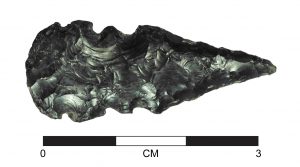Join SCAS for “The Archaeology of Native American Persistence at Mission San José,” a talk by Lee Panich, Ph.D., Associate Professor of Anthropology, Santa Clara University. The talk will be held on May 10, 2018, at 7:30 pm at the Santa Cruz Live Oak Grange Hall at 1900 17th Ave, Santa Cruz, CA 95062 (click here for Google Maps directions).
 Archaeological investigations at Mission San José in Fremont, California, have revealed large areas of the mission landscape. Of particular importance are several projects conducted in the mission’s Native American neighborhood, where archaeologists have documented the remnants of two adobe dwellings and other features. This talk will offer a preliminary synthesis of previous archaeological research at Mission San José, focusing on the implications of material evidence for understanding the persistence of indigenous cultural practices under missionization. Materials considered include flaked stone artifacts, shell and glass beads, modified ceramic disks, and faunal and floral remains. Taken together, archaeological research conducted at Mission San José suggests that native people rearticulated various practices within the mission, but did so in ways that were consistent with existing traditions and cultural knowledge.
Archaeological investigations at Mission San José in Fremont, California, have revealed large areas of the mission landscape. Of particular importance are several projects conducted in the mission’s Native American neighborhood, where archaeologists have documented the remnants of two adobe dwellings and other features. This talk will offer a preliminary synthesis of previous archaeological research at Mission San José, focusing on the implications of material evidence for understanding the persistence of indigenous cultural practices under missionization. Materials considered include flaked stone artifacts, shell and glass beads, modified ceramic disks, and faunal and floral remains. Taken together, archaeological research conducted at Mission San José suggests that native people rearticulated various practices within the mission, but did so in ways that were consistent with existing traditions and cultural knowledge.
Lee Panich is an Associate Professor of Anthropology at Santa Clara University. His research employs a combination of archaeological, ethnographic, and archival data to examine the long-term histories of the indigenous societies of western North America. One of Lee’s current projects involves the analysis of archaeological materials from multiple data recovery projects at Mission San José conducted over the past two decades. This work builds on his previous research into the native inhabitants of Mission Santa Clara, on the campus of Santa Clara University, and Mission Santa Catalina in Baja California, Mexico. Lee is also the co-director of a collaborative research project examining autonomous indigenous communities in nineteenth-century Marin County, California.



